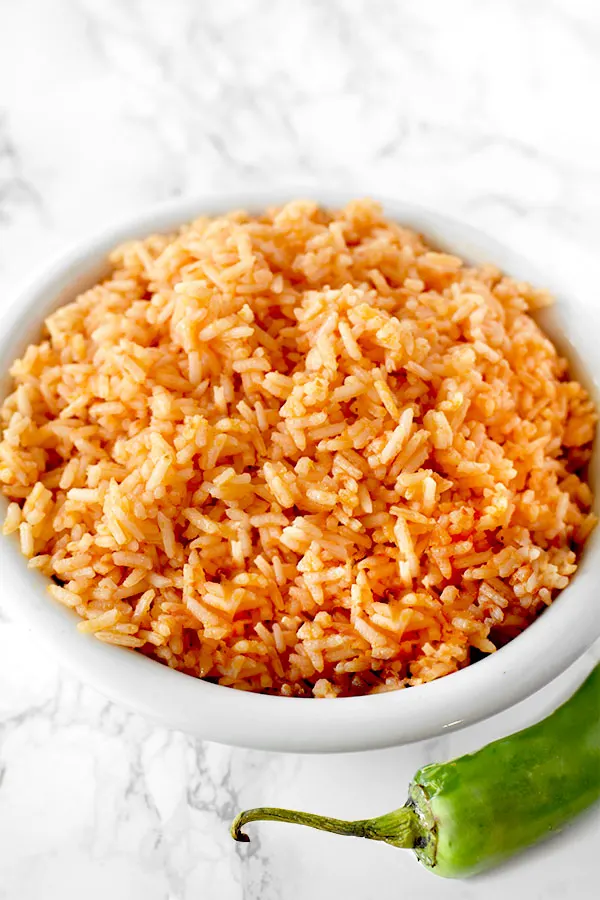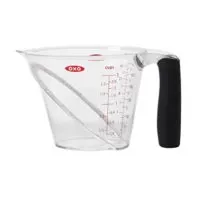Arroz Rojo, also known as Mexican red rice, is a classic Mexican side dish. Serve alongside your favorite meat, chicken, or vegetarian Mexican dish.

When I first made arroz rojo, I was a little worried that it would taste too similar to Israeli red rice that I wouldn’t be able to share it with you. Boy was I wrong.
They taste nothing like. This rice is a little spicy. However, if you leave out the chile, it won’t be.
Also unlike Israeli red rice, this recipe calls for pureed tomatoes instead of tomato paste and the onions are pureed with them instead of chopped.
Now, I admit that I could be wrong, but there seem to be two types of Mexican red rice. Arroz rojo and arroz Mexicano.
When I looked up recipes in Spanish for this rice, they were all pretty much the same and very simple. Tomatoes, onion, garlic, and some added the chili while others left it out.
Then I came across arroz Mexicano, or in English, Mexican rice.
These recipes seemed pretty much the same with one exception. They also called for peas and carrots. Or would that be two exceptions?
I would have thought that they were possibly different variations of red rice except for two things.
The first reason was that most, if not all, recipes I saw for Mexican rice included peas and carrots.
The other reason was that they were often listed as separated recipes on the same site under different names.
WHY SORT RICE
Sorting rice is useful because I’ve actually found bugs in rice before, especially with already opened bags of rice.
To be sure the rice is clean, measure out how much rice you need, then pour some of it out onto a white plate.
Sift through the rice to make sure there are no bugs – some of which look like small worms.
When done, pour the sorted rice into a pot and repeat with the remaining rice.
As a secondary step, I then fill the pot with water and agitate the rice with my fingers. This helps get anything that may have been missed to float to the top.
Pour out the water, and if you found anything, repeat until nothing comes up.
HOW TO STORE DRY RICE
Store the remaining dry rice by placing it in an airtight container or a resealable plastic bag. Keep it in a cool, dark place.
Doing so will protect the rice from bugs.
I always check the rice before using it even when it is stored well, just in case.
WHY WASH RICE
There are three benefits to rinsing rice.
Firstly, it removes any debris.
Secondly, it removes surface starch. If the starch is not removed, it can cause the rice to clump together and get gummy as it cooks.
Thirdly, if there are any bugs in the rice that weren't caught, they will float to the surface while being washed.
Some say to rinse the rice repeatedly until the water runs clear. This isn’t necessary.
Instead, rinse the rice thoroughly a few times. After that, most of the starch should be removed and the water should be only slightly cloudy.
The way I like to wash rice is by putting it in a large bowl or a pot and filling it with water. Then, I shape my hand into a claw and use it to agitate the rice.
This brings up both debris and bugs that may have been missed during sorting.
WHY TOAST RICE
Toasting rice is a step some recipes require where you first lightly fry the uncooked rice. This step is usually done with rice that has not been rinsed.
As with toasting spices and nuts, toasting grains before cooking can enhance their flavor.
Rice is no exception, as it gains a nutty depth which adds an extra layer of flavor to a final dish.
Another benefit is that by toasting the rice first, you are cooking the starches.
This, like washing rice, helps prevent the rice from being sticky. Instead, each grain cooks separately.
RATIO WATER TO RICE
There are many different types of rice. The most popular types require two cups of water for one cup of rice. Some, however, need less water:
Short Grained Rice needs 1 and ⅛ cups water.
Basmati Rice needs 1 and ¼ cups water.
American Long Grain Rice needs 1 and ½ cups water.
Jasmine Rice needs 1 and ¾ cups water.
Also, when multiplying the recipe, rice often needs less water than you’d think. For example, with American long grain rice:
1 cup rice needs 1 and ½ cups water.
2 cups rice need 2 and ¾ cups water.
3 cups rice need 3 and ½ cups water.
HOW TO STORE RICE
Transfer the cooled, cooked rice into an airtight storage container or a resealable plastic bag. Make sure to remove as much air from the bag as possible before sealing it.
Store in the refrigerator for 3 to 5 days.
HOW TO FREEZE RICE
Transfer the cooled, cooked rice into a resealable freezer bag, making sure to remove as much air from the bag as possible before sealing.
Store for up to 6 months. After that, it is still safe to eat, but the quality begins to degrade.
REHEATING RICE
FROM THE FRIDGE
When reheating, place the rice in a pot, sprinkle a teaspoon of water over the top to help loosen stuck, dried grains, then place.
Heat over medium heat, stirring constantly to keep the grains moving, but be careful not to mash them.
FROM FREEZER
Frozen grains can be added directly to hot dishes like stir-fries. If you’re planning on eating it on its own, follow the steps above.
Recipe Tip:
If you have leftover restaurant style salsa, you can use that instead of making the sauce.
However, I wouldn't recommend using the very spicy version, since this rice is mildly spicy, if at all.
Arroz Rojo - Mexican Red Rice

Arroz Rojo is a classic Mexican side dish where rice is cooked in salsa rojo instead of water.
Ingredients
Sauce
- 2 tomatoes
- ½ medium white onion
- 1 garlic clove
Rice
- 1 cup rice, sorted and rinsed well (200grams)
- 2 tablespoons oil
- Salt
- 1 serrano pepper, optional
Instructions
- Blend the tomatoes, onion, and garlic into a puree. Measure to make sure you have two cups of sauce. If you have more than that, remove the remaining sauce. If you have less, add water.
- Heat the oil in a pot and add the rice. Stir constantly until the rice gets golden brown. About 3 minutes.
- Add the sauce and bring to a boil. Reduce to a simmer. Add salt to taste and serrano pepper if desired.
- Cook for 15 minutes or until the sauce has cooked completely into the rice.
- If the rice still looks wet after the sauce is gone, cover the the pot and let it sit. Stir every 5 minutes or so until the rice absorbs the moisture and isn’t sticky.
Recommended Products
Some of the links below are affiliate links, which means that if you choose to make a purchase, I will earn a small commission. This commission comes at no additional cost to you.
Nutrition Information:
Yield:
4Serving Size:
1Amount Per Serving: Calories: 136Total Fat: 7gSaturated Fat: 1gTrans Fat: 0gUnsaturated Fat: 6gCholesterol: 0mgSodium: 150mgCarbohydrates: 16gFiber: 1gSugar: 3gProtein: 2g


